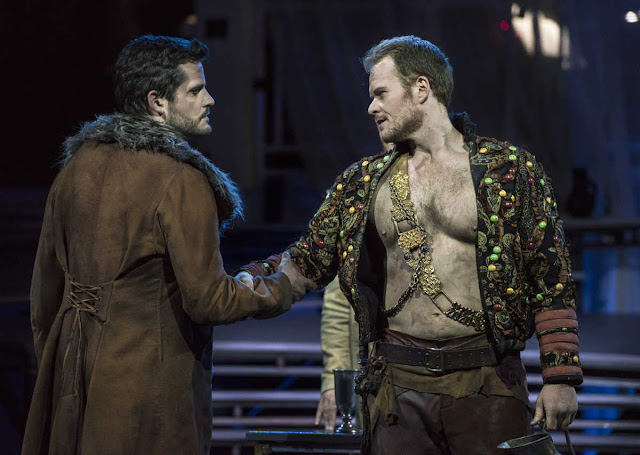 |
| Stacy Fischer in "Photograph 51" (photo: Maggie Hall) |
“I love the shapes of things”. So spoke British
scientist Rosalind Franklin. That statement expressed in concrete
terms her focus on determining the form that would become known as the deoxyribonucleic acid molecule's double helix,
otherwise known by us mere mortals as DNA. The year was 1952, a
watershed date in the development of modern science's discovery of
the existence and shape of DNA. That eureka moment led to the
awarding of the Nobel Prize for its discoverers. Or did it? Three
male scientists were granted the award, ignoring the demonstrable
fact that their claim to have been the first and only discoverers was
a sham, given the role of one female scientist, the completely
overlooked British biophysicist Franklin. In a word, she was robbed.
How that gradually, insidiously, inevitably happened is the crux of
the current offering at Central Square Theatre, Photograph 51 by
playwright Anna Zeigler. As the character of Franklin herself says in
the play, “we see everything except sometimes what is right in
front of us”. And for not taking that leap as opposed to more
deliberate study, she was ignored.
 |
| Josh Gluck & Stacy Fischer in "Photograph 51" (photo: Maggie Hall ) |
It was Zeigler's intention to right that wrong, at long
last. Now, in its thirtieth season, along with commemorating Central
Stage Theatre's tenth anniversary, Nora Theatre has mounted the play,
with all of its timeliness intact and then some. It's also a
production of the Catalyst Collaborative @ MIT. Interestingly, it's
the second time Nora Theatre has presented this play (the first was
only six years ago). The title refers to the x-ray diffraction
image, known as photo 51, at King's College in London. The female
biophysicist (an x-ray crystallographer, if you must know) was
Rosalind Franklin (Stacy Fischer). The three male doctors were
Francis Crick (John Tracey), James Watson (Michael Underhill) and
Maurice Wilkins (Barlow Adamson). Donald Caspar (Jesse Hinson) and
Raymond Gosling (Josh Gluck) also play supporting roles. All are
integral to this presentation, with a special nod to “colleagues”
Fisher and Adamson, the Greek chorus role by Gluck, and the
appropriately energetic turn by Underhill.
 |
| John Tracey & Michael Underhill in "Photograph 51" (photo: Maggie Hall) |
The character of Franklin isn't softened in the play
from what it would appear to have been in life, keeping her from
standing out, what with the blatant misogyny that surrounded her and
led to one of history's worst examples of unfairness and
unconscionable chauvinism. Most frustrating is that we will never know whether
Franklin would have made the leap to the explanation if she hadn't
been marginalized; would she have taken the risk? As aptly Directed
by Rebecca Bradshaw, with Scenic Design by Kristin Loeffler, Costume
Design by Chelsea Kerl, Lighting Design by Aja M. Jackson and Sound
Design by Elizabeth Cahill, this current production doesn't attempt
to answer this. (Those who have been paying attention might note
that's an ironically all-female creative team; one might also ask why
we noticed that). With a length of just ninety intermission-less
minutes, the time seemed to fly by in this remarkable retelling of a critical moment in the herstory of medical science.
What doesn't fly by is the excruciating feeling that
you've seen this sort of thing happen, either covertly or overtly,
virtually every day of your life, and it doesn't seem to be getting
any better anytime soon. In Franklin's time, she was habitually
addressed as “Miss” rather than “Doctor”, and not even
allowed to eat with her male colleagues. Times may have changed
somewhat, but not completely. Given the current state of the
disunion, maybe theater is our last resort. One can only hope that
diversity overcomes perversity, and that our scientific and
theatrical heroes continue, virtually every day, to look at lot more
like us.




















